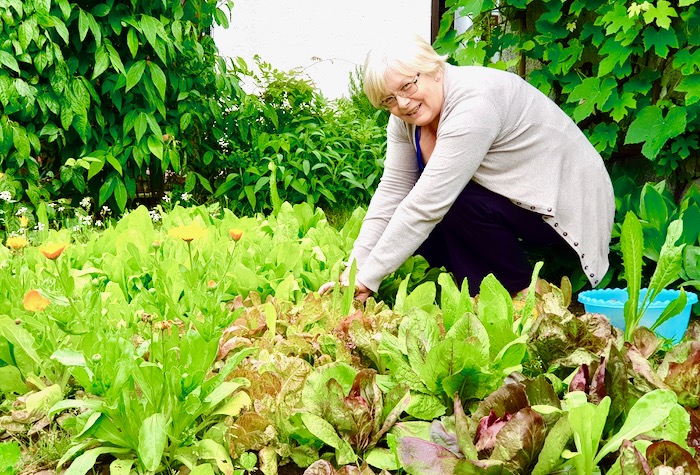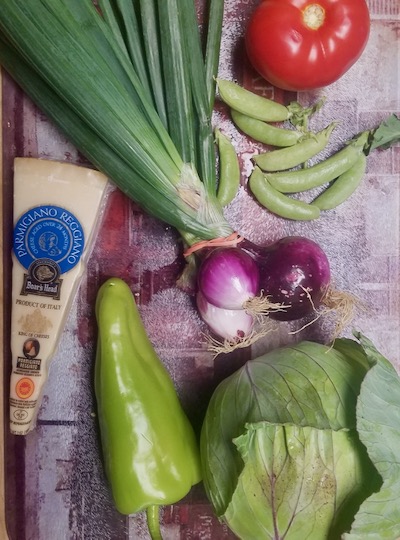
SHARING A POT OF SUMMER SOUP ACROSS 4,300 MILES
RECONNECTING IN A SEASON OF SEPARATION—Can something as simple as a pot of soup help us to reconnect, even the midst of this global pandemic? Two regular contributors to this online magazine are Elisa Di Bendetto and Martin Davis—who are physically separated by 4,300 miles. She is based in Italy; he’s near Washington D.C. They became friends through the International Association of Religion Journalists and have visited in person occasionally over the years. As spring turns to summer, they both were reminded via email and social media that their thoughts were turning toward their mutual love of cooking with fresh ingredients, especially the first crop of summer vegetables. Today they’re coming together to talk about an Italian classic—minestrone.
Elisa: As a child, I would eat anything except minestrone. Lots of children considered it a type of punishment, sort of like being forced to eat cauliflower. It was only later on that I started enjoying that traditional, light and healthy dish that my mother used to cook year-round, creating the perfect mix of fresh vegetables from our grandma’s vegetable garden.

Martin Davis’s starting point for minestrone.
Marty: Where I grew up in the American South, I didn’t like minestrone, either. Of course, where I grew up, the only minestrone I knew came from a can in the soup aisle. It was mushy and generally disgusting. Even the adults didn’t like it.
My mom taught be to cook when I was little. After I left home, I got interested in Italian cooking. That’s where I first discovered what minestrone truly was all about. And when you visited our home and began talking with me about it, I really got into it.
Elisa: As an Italian with friends and colleagues based in all continents, I am frequently asked for advice about—and the “secret ingredients” of—many popular Italian dishes: pasta, piazza, lasagne and so on. But, never before had I been asked about minestrone, one of the most popular foods in Italian peasant cuisine.
What many people don’t understand about minestrone, and something that you, Marty, had figured out, is that it’s a simple dish—but it’s an art form, too. While some foods and dishes are typical of a specific region or area, you can find minestrone anywhere in Italy. That means you will see a huge variety of recipes for the same meal, which is usually served as a first course. Be ready to experience some differences, according to the region and the season. They can come both in the ingredients—with broken spaghetti or soup pasta, and even rice or legumes and other cereals added in the pot—and in the preparation—vegetables usually are diced or cut into pieces, but sometimes they are smashed before serving.
Marty: The unpredictability of minestrone is what appeals to me, Elisa. While I have a few core ingredients that I use in every pot, the other vegetables that I add depend on the season. Spring is heavy on different onions, as well as potatoes and carrots and snow peas.
In the summer I dress up my pots with fresh squashes, corns, okra and field peas. In the fall, it’s October beans and cabbages, plus a wide range of root vegetables, that make their way into my pot. Honestly, whatever is fresh and looks good at the Farmer’s Market every Saturday is what I’ll use.

Elisa’s soffritto mixture as she begins her minestrone.
Elisa: My mother explains it this way, “We always begin by making a soffritto (base flavor for countless classic dishes) with onion, carrot and celery, which are the three base vegetables for many Italian dishes.” My mother still remembers her grandmother making minestrone. “I remember that her recipe always included beans, no matter the time of the year. Every family, even the poorest ones, would grow beans in their garden. Besides that, beans made it filling and nourishing.”
Nowadays, we add some fancy foods, such as croutons. In the past, they used to add stale bread in it. In this way, they would not waste any food, as my mother recalls: “In farms, when they butchered pork, they used to add its bones in the minestrone.” Today, cut up pancetta or pre-cooked pork rind (cotenne), which are frequently used to add flavor.
Marty: I didn’t know that you could add meat or bone marrow! As I noted above, we didn’t make minestrone growing up, but we did make beef vegetable soup, usually in the fall. I wonder if there is a connection between that and minestrone?
Elisa: Perhaps. You can basically use anything in this soup, and that’s why in the Italian language we use the word minestrone to describe a messy, disorderly, set of different things.
Marty: Well, that’s what my Minestrone is—a messy disorderly set of different things that blend together over time to produce a simply amazing bouquet of flavors that’s pure joy to eat. I generally cook my pot for 6 hours or more at a very low heat.
Elisa: I’m surprised to learn that you usually cook it for over 6 hours. In Italy, it generally takes about 2 or maybe 3 hours to cook, depending on the vegetables you use.
Marty: I am a fan of slow-cooking. I cook many things that way. Even one of my favorite Low Country meals, Gumbo.
Elisa: Yes! I remember that that’s what you prepared for me when I visited you in the United States. Perhaps we should talk about that sometime?
Marty: Perhaps—but for now, let’s compare recipes.

Elisa’s Authentic Minestrone Soup
Ingredients
Extra-virgin olive oil
Salt and freshly ground black pepper
1 medium yellow onion, chopped
2 medium carrots, peeled and chopped
1-2 ribs celery, chopped
Water (you can also use vegetable stock)
2 medium tomatoes
Seasonal vegetables and leafy vegetables (greens) to taste (usually carrots, legumes, beans, peas, potatoes, zucchini, green beans, kale, Swiss chard). We never use vegetables with a very strong flavor, such as peppers, cauliflower, broccoli. They are not usually included in the recipe, nor do we use eggplant.
Cooking
Put oil in the bottom of a big pot and add onions (make sure it’s big enough to hold all your ingredients). Add onions first. Chop the carrots and then add them in the pot while you chop the celery. Add the celery and a pinch of salt. Let your ingredients rosolare (saute) without browning until everything is soft but not colored.
Cut your vegetables—except potatoes!—into small pieces and strips and add them into the pot, one by one, so that they can absorb the flavor of the ingredients you have added previously.
Add abundant water to cover, bring to a boil and then to a gentle simmer. Allow simmering for about 1,5 hours and if it’s getting too thick, add some water to loosen. Add the potatoes later, so they can cook through before serving time. When all the vegetables are soft (almost meltingly soft), mash the potatoes and stir.
Serve
You can serve it hot, warm or room temperature. It tastes even better the next day.
To provide an extra flavor to your minestrone you can add some extra-virgin olive oil, croutons or grated parmesan on top before serving. You can also cook some rice or pasta separately and add it to the pot at the very last.
Marty’s Minestrone
Ingredients
½ cup high-quality olive oil
3-4 garlic bulbs
Salt and pepper
Fresh herbs—Parsley, Basil, Thyme, Oregano. (If you don’t grow it, buy fresh sprigs)2 or 3 fresh tomatoes (any tomato will do – I like Roma, my wife prefers a medium-sized slicing tomato
Purple onion (with green stems)
Carrots
A wedge of high-quality Parmesan cheese
Beans (stay away from canned—use dry or fresh picked)
Cabbage
Peppers (I like Cubanelle, but any type will do)
Potatoes
Parsnips
Cooking
Add about 4 cups of water or vegetable stock to a pot. Quarter the tomatoes and drop them in. Then add the purple onion (onion and stems), carrots, and garlic. Bind all your herbs with some twine and drop them into the pot. Add the Olive Oil and a generous amount of salt and pepper. Cover, bring to a boil, then turn to medium heat. Let simmer for 1.5 hours, until the tomatoes begin to break apart. Remove the herbs.
Add the remaining vegetables in any amount that you desire. Bring the pot back up to a boil for 2-3 minutes, then reduce to the lowest heat possible. Add the wedge of Parmesan cheese, cover, and let cook another four hours.
If you like, cook some pasta separately.
Serve
Put the pasta in the bottom of a bowl. Using a ladle, cover the noodles with minestrone. Finish with fresh ground parmesan and Parsley. Serve with bread or grilled cheese sandwiches.


What a joy to read, my friends. You both are writers with warm hearts and many talents.